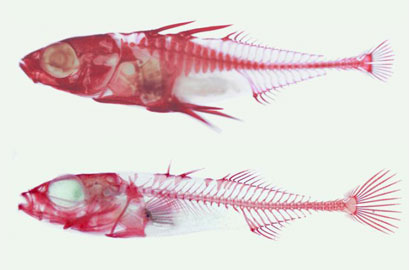|
Stickleback fish study uncovers
evolutionary secrets
Species provides
laboratory for biologists to study evolution
By AMY ADAMS
Whales, snakes and some lizards and fish all lost their hind
limbs (or fins) as they evolved from their four-legged ancestors.
New data from the School of Medicine suggest that at least in some
fish alterations in a single gene bring about this evolutionary
change.
"People have been interested in limbs for a long time because they
show such variability in different animals," said David Kingsley,
PhD, professor of developmental biology, who led the work. "The
debate has been how many genes account for these differences."
The study, published in the April 15 issue of Nature, took
advantage of a unique species of fish called the threespine
stickleback. Pockets of sticklebacks were isolated by geologic
changes at the end of the Ice Age 10,000 years ago, with each newly
separated population evolving in response to local ecological
conditions. A handful of the thousands of populations around the
world lost their hind fins and associated spines, probably to avoid
local predators that grabbed the fish by those spines.
Kingsley, who is also an associate investigator with the Howard
Hughes Medical Institute, said the debate over how limbs evolve has
been stymied because most animals that evolved to have fewer or
altered limbs also have a host of other genetic changes, making it
hard for scientists to tease out the number and location of genetic
changes most important for altering the limb. Sticklebacks, with
their recent divergence into many distinct populations, present an
opportunity to study recent limb evolution.

The marine stickleback (top)
has a large pelvic hind fin but other stickleback populations that
evolved in freshwater locations have lost this pelvic fin (bottom).
Tracing the evolutionary shift, researchers have discovered that
changes in the hind fin skeleton are controlled by alterations in
activity of the Pitx1 gene. Photo:
Mike Shapiro
The group looked at two populations of freshwater threespine
sticklebacks that had lost their hind fins. Working with senior
co-author Dolph Schulter of the University of British Columbia, the
group crossbred a population of Vancouver freshwater sticklebacks
with their four-finned marine relatives. All the resulting
offspring had hind fins. These four-finned offspring, which had one
set of genes from each parent, indicated to the researchers that
fish require only a single copy of the saltwater genes to develop
hind fins.
The researchers then interbred these finned offspring to produce
fish with a range of hind fin lengths. Some fish lacked hind fins
entirely while others had the fully formed fins of their saltwater
grandparents. Still other fish had partially formed hind fins or
structures that were slightly larger on one side.
Graduate student and co-first author Melissa Marks and former
postdoctoral scholar Katie Peichel, PhD, found that the presence of
hind fins seemed to correlate with changes at one particular
location of the fish chromosomes. A few other chromosome regions
had smaller effects on the length and shape of pelvic features, but
most of the major evolutionary change could be attributed to a
single region. Mike Shapiro, PhD, a postdoctoral scholar and
co-first author, found that a gene located at that region is the
stickleback version of a gene in mice called Pitx1 that, when
mutated, causes mice to have greatly reduced hind limbs. These mice
often have asymmetric limb and pelvic reductions, much like the
sticklebacks.
These experiments helped explain how mutations at Pitx1 could nudge
one population of fish toward losing hind limbs, but they don't
hint at whether these mutations were a one-time solution or a
widely used strategy.
The researchers addressed this larger evolutionary question using a
second population of freshwater sticklebacks discovered by
co-author Bjarni Jonsson from the Institute of Freshwater Fisheries
in Iceland. The Icelandic fish also lack hind fins, but evolved
thousand of miles away from the Vancouver fish. Marks bred the two
freshwater sticklebacks and produced an aquarium full of fish
lacking hind fins.
Breeding the Icelandic sticklebacks to a four-finned saltwater fish
once again generated offspring with hind fins. Together, these
experiments suggest that the same set of genes was responsible for
the loss of hind fins in two widely separated geographic
locations.
"It looks like evolution is using this gene repeatedly," Kingsley
said.
The work fits into a growing pattern in evolutionary biology.
Although animals look dramatically different, in some cases only a
few gene changes account for the differences. "It looks like a
small number of genes can have large effects," said Shapiro.
The work also addressed how a few gene changes cause large
evolutionary shifts. Most genes have many roles in an animal, so
mutations kill the animal rather than altering its shape. Mice with
mutated Pitx1, for example, die soon after birth. In the
sticklebacks, however, the group found alterations in the location
of the Pitx1 gene activity. Although the Pitx1 protein doesn't show
up in the developing pelvic region of the fish lacking hind fins,
the gene still does its normal job in other regions such as in the
thymus and olfactory bulbs.
"We think this is how evolution has been able to sidestep major
problems. It only subtracts part of what the gene normally does,"
Kingsley said.

|

